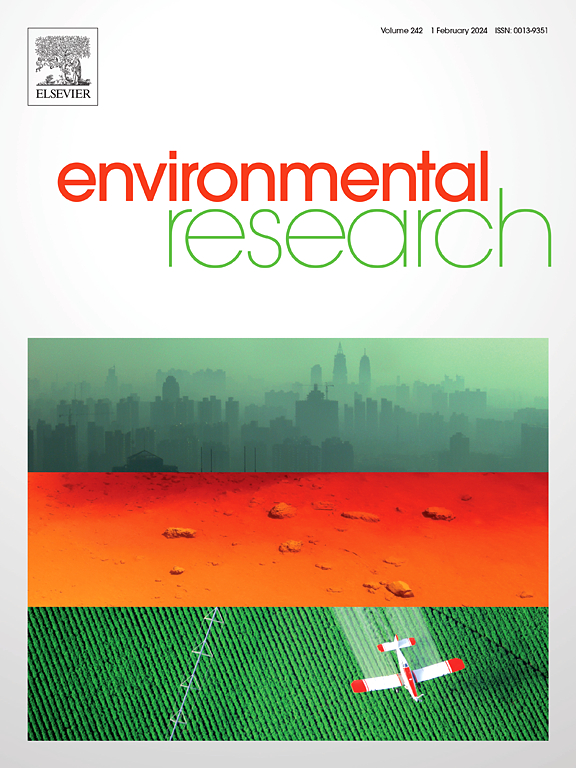Enhanced adsorption of Pb(II), Cd(II), and Zn(II) by tannic acid-modified magnetic fly ash-based tobermorite
IF 7.7
2区 环境科学与生态学
Q1 ENVIRONMENTAL SCIENCES
引用次数: 0
Abstract
Despite the high adsorption capacity of fly ash-based tobermorite (TFA) for Pb(II), its performance for Cd(II) and Zn(II) was poor, and it proved difficult to separate and recover as a powdered adsorbent. Based on a multifunctional design strategy, this study proposes the innovative use of a tannic acid-modified fly ash-based magnetic tobermorite composite material (TFA-Fe3O4/TA). Characterization revealed that TFA-Fe3O4/TA possessed superparamagnetic properties and enriched hydroxyl groups. The adsorption performance of TFA-Fe3O4/TA for heavy metals was significantly improved. In the single-metal system, the adsorption capacities of TFA-Fe3O4/TA for Pb(II), Cd(II), and Zn(II) were 344.0 mg/g, 108.1 mg/g, and 99.16 mg/g, respectively, representing an increase of 14.97 %, 72.13 %, and 73.53 %, respectively, compared to unmodified TFA. The adsorption procedure followed the Langmuir model and the pseudo-second-order kinetic model, signifying monolayer chemisorption. Moreover, in the multi-metal system, TFA-Fe3O4/TA maintained adsorption capacities of 112.7, 58.81, and 65.56 mg/g for Pb(II), Cd(II), and Zn(II), respectively, although these values decreased compared to the single-metal system. The primary adsorption mechanisms involved coordination, ion exchange, metal-π interaction, electrostatic interaction and pore adsorption. TFA-Fe3O4/TA demonstrated exceptional integrated functions of "adsorption-separation-recovery," making it an ideal adsorbent material for removing Pb(II), Cd(II), and Zn(II) from contaminated water.

单宁酸改性磁飞灰基托贝莫来石对Pb(II)、Cd(II)和Zn(II)的增强吸附
粉煤灰基托贝莫来石(TFA)对Pb(II)具有较高的吸附能力,但对Cd(II)和Zn(II)的吸附性能较差,且作为粉状吸附剂难以分离和回收。基于多功能设计策略,本研究提出了单宁酸改性粉煤灰基磁性托贝莫来石复合材料(TFA-Fe3O4/TA)的创新用途。表征表明TFA-Fe3O4/TA具有超顺磁性和丰富的羟基。TFA-Fe3O4/TA对重金属的吸附性能显著提高。在单金属体系中,TFA- fe3o4 /TA对Pb(II)、Cd(II)和Zn(II)的吸附量分别为344.0 mg/g、108.1 mg/g和99.16 mg/g,比未改性TFA分别提高了14.97%、72.13%和73.53%。吸附过程符合Langmuir模型和拟二级动力学模型,为单层化学吸附。此外,在多金属体系中,TFA-Fe3O4/TA对Pb(II)、Cd(II)和Zn(II)的吸附量分别为112.7、58.81和65.56 mg/g,但与单金属体系相比有所下降。吸附机理主要包括配位、离子交换、金属-π相互作用、静电相互作用和孔吸附。TFA-Fe3O4/TA表现出优异的“吸附-分离-回收”综合功能,是去除污染水中Pb(II)、Cd(II)和Zn(II)的理想吸附剂材料。
本文章由计算机程序翻译,如有差异,请以英文原文为准。
求助全文
约1分钟内获得全文
求助全文
来源期刊

Environmental Research
环境科学-公共卫生、环境卫生与职业卫生
CiteScore
12.60
自引率
8.40%
发文量
2480
审稿时长
4.7 months
期刊介绍:
The Environmental Research journal presents a broad range of interdisciplinary research, focused on addressing worldwide environmental concerns and featuring innovative findings. Our publication strives to explore relevant anthropogenic issues across various environmental sectors, showcasing practical applications in real-life settings.
 求助内容:
求助内容: 应助结果提醒方式:
应助结果提醒方式:


